

Château Nolibos. Un article de Wikipédia, l'encyclopédie libre.
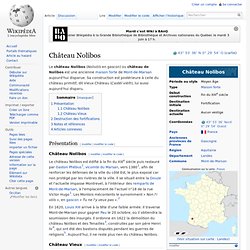
Le château Nolibos (Nolivòls en gascon) ou château de Nolibos est une ancienne maison forte de Mont-de-Marsan aujourd'hui disparue. Sa construction est postérieure à celle du château primitif, dit Vieux Château (Castèl vièlh), lui aussi aujourd'hui disparu. Présentation[modifier | modifier le code] Château Nolibos[modifier | modifier le code] En 1620, Louis XIII arrive à la tête d'une faible armée.
Château Vieux[modifier | modifier le code] Destruction des fortifications[modifier | modifier le code] Au XVIIIe siècle, on commence à concevoir la ville comme un cadre agréable et sain. Il ne reste plus de l'époque médiévale que quelques vestiges[10] : des remparts, les deux maisons romanes fortifiées de Mont-de-Marsan et le donjon Lacataye. Notes et références[modifier | modifier le code] Articles connexes[modifier | modifier le code] Liste des châteaux des Landes. Peyrehorade. Un article de Wikipédia, l'encyclopédie libre.

Peyrehorade est également le nom de personnages (les hôtes du narrateur) dans la nouvelle la Vénus d'Ille de Mérimée. Géographie[modifier | modifier le code] Peyrehorade est située dans le Pays de l'Adour landais, Pays d'Orthe en Maremne entre les Landes de Gascogne, le Pays basque et le Béarn, au cœur d'une région vallonnée et verdoyante. Les terres de la commune sont arrosées par le gave de Pau et le gave d'Oloron (affluent de ce dernier) qui s'y réunissent pour former les gaves réunis. Climat[modifier | modifier le code] Donjon Lacataye. Donjon Lacataye on the banks of the Midou, Mont-de-Marsan History[edit] La Cataye consists of two joined Romanesque houses, which one sees perfectly while entering the current museum whose central internal wall includes Romanesque windows, a sign that one of the two houses was built before the second.

These houses belonged to the Viscount's family and were more or less abandoned starting from the 15th century, when the Viscounts moved away from their town of origin. During the 16th century, their upper parts were modified and they were equipped with crenellations. The material used is coquillère, a local sedimentary rock. The name Cataye comes from the Spanish verb “castar”, to supervise. In 1860, Antoine Lacaze, mayor and owner of the keep, gave it to the town to house troops. Château de Villandraut. Domestic quarters The Château de Villandraut is a ruined castle in the commune of Villandraut in the Gironde département of France.
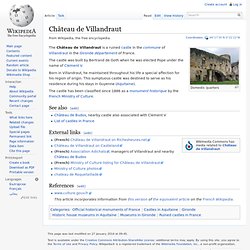
The castle was built by Bertrand de Goth when he was elected Pope under the name of Clement V. Born in Villandraut, he maintained throughout his life a special affection for his region of origin. This sumptuous castle was destined to serve as his residence during his stays in Guyenne (Aquitaine). The castle has been classified since 1886 as a monument historique by the French Ministry of Culture. See also[edit] Château de Roquetaillade. View of the castle.
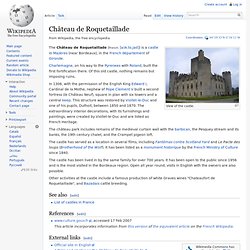
The Château de Roquetaillade (French: [ʁɔk.tɑ.jad]) is a castle in Mazères (near Bordeaux), in the French département of Gironde. Charlemagne, on his way to the Pyrenees with Roland, built the first fortification there. Of this old castle, nothing remains but imposing ruins. In 1306, with the permission of the English King Edward I, Cardinal de la Mothe, nephew of Pope Clement V built a second fortress (le Château Neuf), square in plan with six towers and a central keep.
This structure was restored by Viollet-le-Duc and one of his pupils, Duthoit, between 1850 and 1870. The château park includes remains of the medieval curtain wall with the barbican, the Pesquey stream and its banks, the 19th century chalet, and the Crampet pigeon loft. The castle has served as a location in several films, including Fantômas contre Scotland Yard and Le Pacte des loups (Brotherhood of the Wolf). Château de Rauzan. Un article de Wikipédia, l'encyclopédie libre.
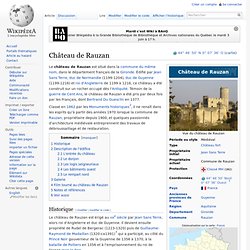
Historique[modifier | modifier le code] En octobre 1370, Bertrand Du Guesclin revenu en France, est fait connétable par Charles V et entame sa grande entreprise : expulser les Anglais. Contrairement aux habitudes de la chevalerie française, il ne procède pas par grandes campagnes avec tout l'ost français, mais préfère reconquérir méthodiquement des provinces entières, assiégeant château après château. Il va chasser les Anglais de la Normandie, de la Guyenne, de la Saintonge et du Poitou, le château de Rauzan tombant en 1377. Château Lagorce. Château Lagorce terrace view.

Château du Hâ. Un article de Wikipédia, l'encyclopédie libre.

Château de Guilleragues. The Château de Guilleragues is a medieval, previously ruined but restored castle in the commune of Saint-Sulpice-de-Guilleragues in the Gironde département of France.
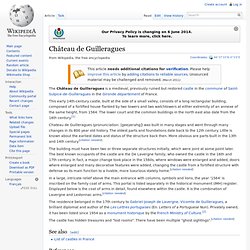
This early 14th-century castle, built at the side of a small valley, consists of a long rectangular building, composed of a fortified house flanked by two towers and two watchtowers at either extremity of an annexe of the same height, from 1564. The lower court and the common buildings in the north east also date from the 16th century.[1] Chateau de Guilleragues (pronunciation: [geeyerahg]) was built in many stages and went through many changes in its 800 year old history. The oldest parts and foundations date back to the 12th century. Château de Curton. Château de Curton Château de Curton is a castle located in the region Entre-deux-Mers in the department of Gironde in the commune of Daignac, and a Bordeaux winery producing wines classified as Bordeaux AOC.
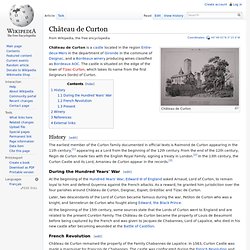
The castle is situated on the edge of the town of Tizac-Curton, which takes its name from the first Seigneurs (lords) of Curton. History[edit] Château de Cazeneuve. Un article de Wikipédia, l'encyclopédie libre. Château de Budos. The Château de Budos The Château de Budos is a ruined castle north of the village of Budos, in the Gironde département of France. History[edit] Château de la Brède. Château de la Brède The Château de la Brède is a feudal castle in the commune of La Brède in the département of Gironde, France. The castle was built in the Gothic style starting in 1306, on the site of an earlier castle. It is surrounded by water-filled moats and an English garden, in the centre of a Bordelais vineyard. Despite modifications over the centuries, it has kept its character as a fortress.
The philosopher Montesquieu (full title: Charles Louis de Secondat, baron de La Brède et de Montesquieu) was born, lived and wrote the majority of his works here. At her death in 2004, the Countess of Chabannes, a descendant of Montesquieu and last owner of the château, bequeathed her belongings, including the castle, to the Foundation named after her. The castle is open to visitors from Easter to 11 November. See also[edit] Château de Blanquefort. Un article de Wikipédia, l'encyclopédie libre. « Le château de Blanquefort a été considéré jusqu'au temps de la Fronde comme l'une des places de guerre les plus importantes de Guienne. Château de Tayac. The Château de Tayac is a castle in the commune of Les Eyzies-de-Tayac-Sireuil in the Dordogne département of France. History[edit] The castle stands on a platform in a cliff. This platform was occupied in prehistoric times; Magdelanian and Azilian artifacts have been found.
Château de Salignac. Château de Salignac The Château de Salignac is the former castle of the Salignac-Fénelon family in the commune of Salignac-Eyvigues in the Dordogne département of France. It dates from the 12th-16th centuries. It has been classified since 1969 as a monument historique by the French Ministry of Culture.[1] See also[edit] Château de Puymartin. Château de Puymartin. The Château de Puymartin is a castle in the commune of Marquay, France, located between Sarlat (8 km) and Les Eyzies (11 km), in the Dordogne department. History[edit] The castle was built during the 13th century.
Château de Montréal. View of the chateau from the north The Château de Montréal is a château in the Dordogne department located near the commune of Issac, in southwestern France. It overlooks the valley of the Crempse River. It was built as a castle in the 12th century and rebuilt in the 16th century. It has been classified as a monument historique by the French Ministry of Culture since 1948.[1] It is now a private residence. History[edit] Claude de Pontbriand, the Seigneur de Montréal, accompanied the French explorer Jacques Cartier on his expedition up the Saint Lawrence River, and was with him on October 3, 1535, when he reached a village of the Iroquois Indians called Hochelaga, on the site of the present day city of Montreal.
Château de Montfort. Château de Montfort The Château de Montfort is a castle in the French commune of Vitrac in the Dordogne département, part of the region of Aquitaine. The castle clings to a promontory overlooking the Cingle de Montfort (Montfort Meander) on the Dordogne River. Its grandiose setting "aroused the envy of those who wished to rule Périgord"[1] so that its history is a long series of battles and sieges. It was taken and razed to the ground by Simon de Montfort in 1214. The castle was later rebuilt, but again destroyed another three times: during the Hundred Years' War, under Louis XI of France and on the instructions of Henri IV of France. Château de Montaigne. The western façade and the inner court. Exterior view The Château de Montaigne is a castle situated on the borders of Périgord and Bordelais, near Bergerac and Saint-Émilion, in the small commune of Saint-Michel-de-Montaigne in the Dordogne département of France.
This fortified castle dates to the 14th century and was the family residence of the Renaissance philosopher and thinker Michel de Montaigne. History[edit] Built in the heart of a majestic park, whose layout was designed by the philosopher himself, the residence was acquired in 1477 by the great-grandfather of Michel, Ramon Eyquem, a Bordeaux trader, who thus acquired the hereditary title of Seigneur de Montaigne ("Lord of Montaigne"). Michel's father, Pierre Eyquem, settled in the castle with his family, and there Michel spent a studious childhood—he is said to have spoken Latin until the age of six—before leaving to continue his studies in French at the college of Guienne in Bordeaux. Architecture[edit] See also[edit] Coordinates: Château des Milandes.
Château des Milandes The Château des Milandes is a small castle in the commune of Castelnaud-la-Chapelle in the Dordogne département of France. Built around 1489, it was the main house of the lords of Caumont until 1535, who preferred to live in this manor house instead of the large, uncomfortable medieval castle of Château de Castelnaud-la-Chapelle. In 1940, the entertainer Josephine Baker rented the château and then bought it in 1947. It has been listed as a monument historique by the French Ministry of Culture since 1986. Château de Jumilhac. Château de Gageac. Gageac Castle is an ancient monument from the 12th/14th/18th centuries. It is located near Gageac-et-Rouillac in the Dordogne department in south-west France.
Location and early history[edit] On the wine trail between Bergerac (18 km) and Sainte-Foy-la-Grande (12 km), this castle is one of the most charming of South Bergerac, overlooking the Dordogne valley and surrounded by vineyards, whose wine has an international reputation. Château d'Excideuil. Château d'Excideuil is a château in Excideuil, Dordogne, Aquitaine, France. Coordinates: Château de Condat (Condat-sur-Vézère) The commandry was definitely founded in the 12th century, and restored around 1540.[1] Château de Commarque. Château de Castelnaud-la-Chapelle. Château de Bourdeilles. Château de Biron. Château de Beynac. Château d'Auberoche.